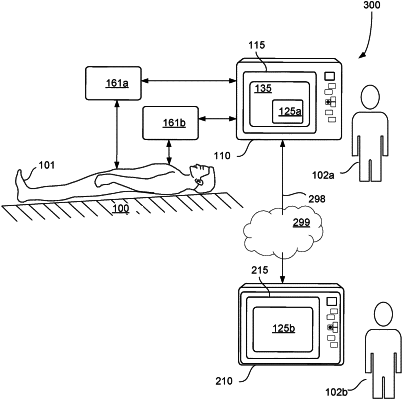| CPC A61B 5/02055 (2013.01) [A61B 5/01 (2013.01); A61B 5/026 (2013.01); A61B 5/14532 (2013.01); A61B 5/14539 (2013.01); A61B 5/14551 (2013.01); A61B 5/339 (2021.01); A61B 5/369 (2021.01); A61B 5/4875 (2013.01); A61B 7/003 (2013.01); A61N 1/39044 (2017.08); A61N 1/3968 (2013.01); A61N 1/3993 (2013.01); G06F 3/0481 (2013.01); G06F 3/0482 (2013.01); G06F 3/04847 (2013.01); G06F 3/0486 (2013.01); G06F 3/04883 (2013.01); G06F 3/14 (2013.01); G16H 10/20 (2018.01); G16H 20/30 (2018.01); A61B 5/021 (2013.01); A61B 5/024 (2013.01); A61B 5/0809 (2013.01); A61B 5/0816 (2013.01); A61B 5/0836 (2013.01); G06F 2203/04803 (2013.01)] | 35 Claims |

|
1. A system for review of clinical data in a playback mode, the system comprising:
an external defibrillator comprising:
at least one first display screen,
a communications module,
at least one first memory, and
at least one first processor coupled to the at least one first memory, the at least one first display screen and the communications module, the at least one first processor configured to:
receive signals indicative of real-time patient data from one or more patient interface devices communicatively coupled to the external defibrillator during ongoing data capture from a patient during a medical encounter with the patient, the one or more patient interface devices comprising electrotherapy electrodes and one or more physiological sensors, and the real-time patient data comprising physiological data comprising electrocardiogram data and one or more of pulse oximetry data and capnography data,
record a time at which a medical event occurred based on the real-time patient data,
control the at least one first display screen to provide a first visual representation of the real-time patient data at an operational interface that displays the real-time patient data at the external defibrillator in real-time as the signals are received, and
transmit the real-time patient data via the communications module; and
at least one auxiliary computing device comprising:
at least one second display screen,
at least one second memory, and
at least one second processor coupled to the at least one second memory and the at least one second display screen, the at least one second processor configured to:
receive the real-time patient data from the external defibrillator, and
control the at least one second display screen to provide a second visual representation of the real-time patient data at a playback interface that is configured to:
display, on an interactive timeline, the real-time patient data comprising the physiological data comprising the electrocardiogram data and the one or more of pulse oximetry data and capnography data as the signals are received and as the real-time patient data comprising the physiological data comprising the electrocardiogram data and the one or more of pulse oximetry data and capnography data is concurrently displayed at the operational interface provided at the external defibrillator,
display an event marker at a position on the interactive timeline that corresponds to occurrence of the medical event,
provide at least two data display controls on the playback interface that enable a user to select a start time and an end time that define a user-selected playback interval,
provide a snap-to-event capability configured to adjust the user-selected playback interval to an automatically-selected playback interval based at least in part on the event marker, wherein the snap-to-event capability enables the playback interface to move at least one of the user-selected start time or the user-selected end time to the position on the interactive timeline that corresponds to occurrence of the medical event, and
replay historic patient data according to the automatically-selected playback interval, during the ongoing data capture from the patient.
|